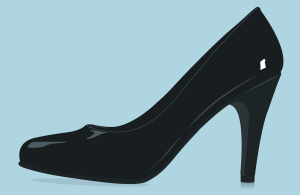I love wearing high heels.
There. I said it.
I love wearing high heels.
I am a cis, mostly hetero feminist woman, and I love this dated, potentially oppressive symbol of heteronormative traditional femininity.
Because I like performing femininity (glitter, lipstick, and high, high heels).
As a feminist and a student of Women and Gender Studies, I often pondered why painful footwear (and the more painful, the better) should hold me in its thrall. Now, as I enter into the burlesque and pole performance scene, I ponder the question more than ever:
Why do some of us want to wear heels?
How did they become so embedded in the cultural narrative that some feminine people continue to love and wear them, even when they’ve been proven to cause structural damage to our bodies, fetishize femininity, and represent a seemingly heteronormative, patriarchal ideal?
And so I began to dig.
A Brief(ish) History of Heels
Surprisingly, high heels originated from a place of female power.
The first documented use of the high heel proper was by Queen Elizabeth I – yes, as in the virgin queen of England who destroyed the Spanish Armada in 1588.
That is, the high heel originated from a place of of absolute monarchy and power.
(One other purported origin of the high heel, by the way, is from the horseback fighters of Persia. These men would wear heels to better hold themselves in their stirrups as they stood to fire their weapons, and when the Persians made their way into the West in the 16th century, men began to adopt these Persian riding heels as a symbol of masculinity. Fancy that.)
But Queen Elizabeth was quoted saying, “I know I have but the body of a weak and feeble woman, but I have the heart of a king, and of a king of England, too.” And in the context of the day, that was her way of asserting that her body (which, here, she’s conflating with her femaleness) didn’t stop her from being powerful, which commanded trust and respect from the men who fought and served under her.
So it stands to reason that men would adopt the heel in the late 1600s, as male clothing (for the upper class, anyway) grew ever more ornate.
When men wore heels, they were sturdy. They helped elevate the wearer above his peers, literally and figuratively.
King Louis XIV of France is best known for his expensively dyed red heels, a fashion choice that was copied by other monarchs across the Western world. In this case, the heel was – again – a symbol of power.
At first, women wore a similar broad, “masculine” heel, but over time, as fashion became less androgynous, their heels became more impractically thin, with tapering near the toes so as to appear more slight when seen under their swishing skirts.
Heels also gave women the ability to showcase their money. The taller you were, the more material and frippery you’d need on your dress. (Aside: This is completely opposite of today’s fashion trends, where short dresses and ripped jeans can often cost more than a well-designed maxi. Go figure.)
But even though heels meant stature and privilege, they were a pain to walk in. Not exactly the most practical fashion choice for anyone who wanted to go out into the world and get shit done.
And then the Enlightenment happened.
This was a period of time in which the “masculine” endeavors of reason and intellect were prioritized over “feminine” pursuits like fashion and social affairs. So men stopped wearing heels due to the culturally accepted reasoning of the time that women were irrational and therefore so were the heels they wore, and men were rational creatures who needed to be able to stand around and argue about philosophy and government without falling on their faces.
In the late 18th century, heels for women fell out of fashion for the exact same reason that they came into fashion: They were symbols of power and privilege.
Only in this case, the power was Marie Antoinette and the French ruling class. So you can imagine that wearing heels and attempting to elevate yourself above others was associated with some rather unsavory consequences.
Heels cycled in and out of fashion for a time, but we can thank photography for helping them step back into the popular consciousness when they were appropriated by pornographers looking to exaggerate the lines of their subjects.
Fortunately for the women featured in these photographs, heels didn’t have to do too much to support their bodies – what with all the sitting and posing.
And mind you, while feminist, sex-positive porn does exist today, for the majority of its history, the pornography industry almost exclusively favored the male gaze.
But even though their wearers were mostly objectified by that male gaze, heels themselves became even stronger symbols of power into the 1950s, when their interiors became fortified by the strength, power, and menace of the American military industrial complex:
It was the 1950s that saw the birth of the stiletto, aka the “killer heel,” which could support a body on a thin, shiv-like base due to innovations afforded by new uses of metal interiors for the heel.
Fascinating, right? But falling down the rabbit hole of fashion history, while really enlightening, doesn’t answer the question of why women want to wear heels today.
Or does it?
The Power of Heels in the 21st Century
The thing about heels is, they have always been about power and privilege. Even when they were co-opted by pornography in the 1850s and co-opted again by Hollywood in the 1900s, they were always about power. It’s just that the source of that power got a little twisted.
Whereas Elizabeth I wore heels to proclaim her masculine features, and women of the 1700s wore heels to masculinize their dress, people today wear heels specifically to emphasize their femininity.
Heels today symbolize feminine sexuality and power. Or, perhaps more specifically: power through sexuality.
There’s an oft-cited story about Marilyn Monroe (who also famously said: “I don’t know who invented high heels, but all women owe him a lot!”) on a walk down the street in New York with a friend. She was completely incognito, embodying her non-famous, Norma Jeane self, when she decided to do a little experiment. She turned to her friend and asked, “Do you want me to be [Marilyn Monroe]?”
And just by thrusting out her chest and walking with her signature wiggle, she instantly transformed from an unrecognizable Norma Jeane into the famous, attention-garnering Marilyn Monroe.
In a patriarchal paradigm governed by the male gaze, secondary sex features like breasts, hips, and buttocks command a sort of secondary power in the form of attention. And the more exaggerated those features, the more attractive we understand them to be. And it just so happens that high heels accentuate those features.
(It’s true: Scientists found that straight men viewing outlines of women walking alternately in flats and heels preferred the ones in heels – and concluded that heels are a “supernormal stimulus.” A supernormal stimulus is the exaggeration of a normal feature that is biologically beneficial, making it more attractive. Kind of like adding sugar to anything. We’re wired for sweet, and when you bump up the sugar content of a food, it makes you want that food more. So the more you accentuate secondary sex characteristics, the more others are attracted to them.)
In a highly visual-centric culture such as ours (see: selfie sticks), where femininity – especially in regards to physicality – is discussed, dissected, photoshopped, policed, and put on display, the currency of the body is so strong that we seek any and all ways to cash in – even if it means pain, misalignment, or even disfigurement.
(And actually, we’ve codified that idea in one of our most popular fairy tales of all time: Cinderella. If you’ve ever read the Grimm Brothers’ version of the tale, then you’ll recall that Cinderella’s stepsisters are so desperate to wear the small and dainty glass heel belonging to our heroine that they actually cut chunks off of their own feet in order to put the slipper on and bag the powerful prince. So there’s that.)
Celebrities, politicians, CEOs, and the cast of Sex and the City make it very clear that powerful women wear heels. It’s just that their frame of reference comes from the legacy of pornography and not of Elizabeth I.
Our power is not in our economic policy, our political acumen, or our creative influence; it’s in our secondary sex features, and the more attractive we are, the easier it is to hold sway in this culture. The Devil doesn’t just wear Prada – she wears Louboutins.
The power of heels through the legacy of pornography is only a token power, however. Because that power is still policed and controlled.
As with Cinderella’s sisters, it’s the power of the desperate and the powerless, and the power of the desperate is one that you’ll seek at all costs because if you’re not worth being looked at, then you don’t have any power at all.
In fact, the Cannes film festival recently turned several women away for not wearing heels on the red carpet. Because obviously being a celebrity or influential woman is contingent upon your ability to hold your own in six-inch designer shoes. Comfortable people aren’t powerful people, don’t you know?
But does that answer the question of why women want to wear heels?
Why Women Want to Wear Heels
I think the desire to wear heels lies in my earlier observation about wanting to perform femininity: because my culture’s currency of feminine power is in sexuality and attractiveness, I’ve been brought up under the assumption that performing the act of “femininity” makes you powerful.
Being a source of attraction makes you feel attractive – and for us, feeling attractive equates to a feeling of power.
Commanding attention is a like a hit of dopamine, and if you don’t believe, me, then I challenge you to count how many times a day you check your Facebook notifications after you post a particularly attractive photo of yourself. It’s science, I tell you.
It’s partially biological – after all, mating is pretty much the point of being alive, if we want to get into the theory of natural selection – because the more attractive you are, the more mating opportunities you potentially have. But it’s also partially (and probably more so) cultural and environmental because we see modeled for us the act of powerful women wearing heels. It’s encoded into our cultural consciousness from a young age.
Personally, I watched every single episode of Sex and the City (many of them multiple times) in high school; around the same time, I adopted the practice of wearing high heels to school most days. I was the salutatorian and the president or captain of several clubs and teams, but I never felt more powerful and in control than when I wore heels on dress up Wednesdays.
Knowing that heels were most likely destroying my feet, knees, hips, and back didn’t stop me from adopting the practice of wearing heels every day in college. (New York City is responsible for eating away at the pumps I refused to take off, even while fighting through crowds of tourists on my nightly trips to Broadway.)
Even when I felt out of control and stressed about grades, as long as I could perform femininity and turn a few heads, I felt a sense of power – and of relief.
I don’t know if the awareness of the act of performing femininity and what its legacy actually means will ever really dissuade me from wanting to wear heels.
I could, as a political act, take them off, be one of the women walking down the red carpet in flats, but there’s something seductive about the power of performing attractiveness, and I don’t know if it’s something that I, or the legions of us who torture ourselves in pumps, stilettos, and platforms every day, will ever truly give up. (Unless of course we see Sarah Jessica Parker go to the guillotine a la Marie Antoinette, although her declaration of “let them eat cupcakes” was a lot more positively received than the French queen’s.)
I think perhaps I’ll more likely continue to appropriate and even parody this objectified token “power” through burlesque – by actively taking back the power of the gaze and manipulating it through parody and play.
So why do women wear heels?
I can’t answer that.
What I do know is that it’s a combination of nature and nurture. And I know that I’m doing it with the awareness of the history, culture, and implications of the act.
But it’s a personal choice, and I think it’s a question that each individual person needs to answer for themselves.
So, how about it? Why do you wear heels?
***
If you’d like to learn more about this topic, I highly recommend the following:
History:
Science:
[do_widget id=’text-101′]
Search our 3000+ articles!
Read our articles about:
Our online racial justice training
Used by hundreds of universities, non-profits, and businesses.
Click to learn more





















